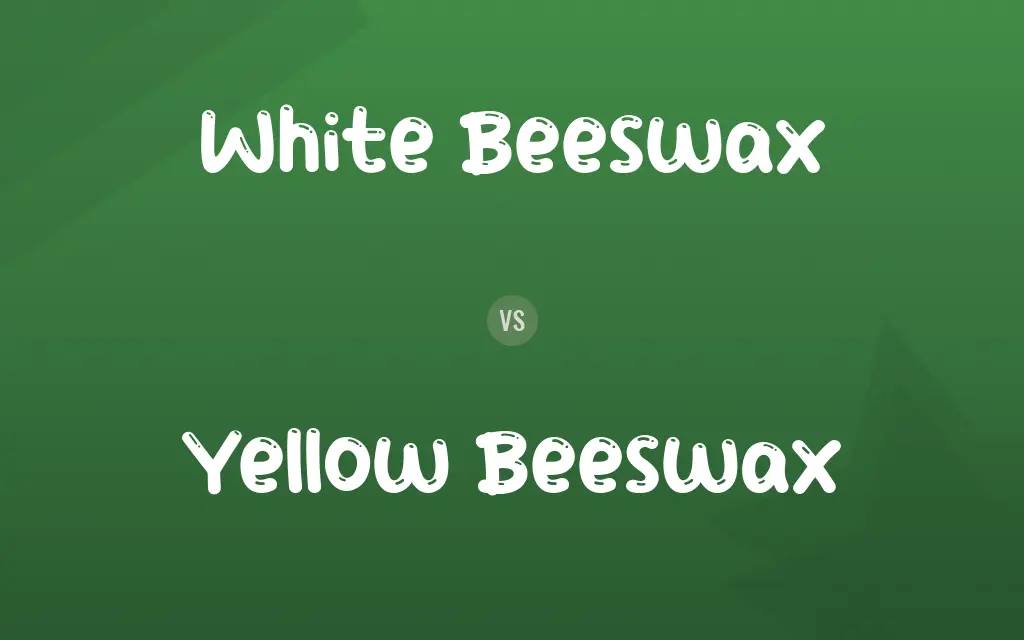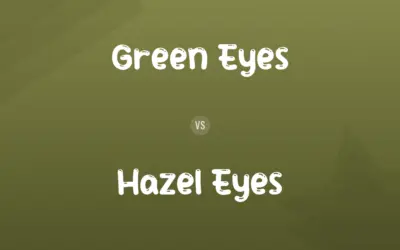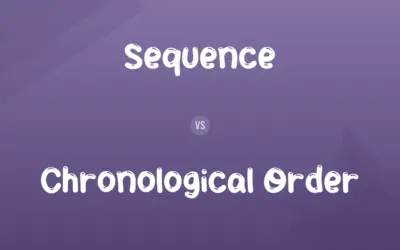White Beeswax vs. Yellow Beeswax: Difference and Comparison
Edited by Muazma Batool — By Muneeza Rehman — Published on March 14, 2024
White beeswax is bleached and filtered for purity and versatility in applications, while yellow beeswax is natural, retaining its color and natural aroma from honey and pollen.

Difference Between White Beeswax and Yellow Beeswax
White beeswax has been either naturally bleached by exposure to sunlight and air or chemically treated to remove its color. Yellow beeswax is the natural, unrefined product directly from the beehive, maintaining its original yellow to golden color.
Muneeza Rehman
Mar 14, 2024
The bleaching process for white beeswax removes not only the color but also much of the natural aroma, resulting in a neutral-smelling product. Yellow beeswax retains the sweet, natural fragrance of honey and pollen, often preferred for its aromatic properties in applications like candles and cosmetics.
Muneeza Rehman
Mar 14, 2024
White beeswax is often used in applications where color purity is important, such as in cosmetics, lotions, and pharmaceuticals, allowing for consistent and predictable coloring. Yellow beeswax is favored in products where the natural color and aroma can be appreciated, such as in natural candles, polishes, and conditioners.
Muneeza Rehman
Mar 14, 2024
Both types of beeswax share similar chemical properties and can be used interchangeably in many recipes and formulations. However, the choice between white and yellow beeswax can depend on the desired aesthetic and sensory qualities of the final product.
Muneeza Rehman
Mar 14, 2024
Both types of beeswax are non-toxic and biodegradable, the natural processing methods used to produce white beeswax are generally considered more environmentally friendly than chemical bleaching. Consumers looking for the most natural and eco-friendly products often prefer yellow beeswax or white beeswax bleached using natural processes.
Muneeza Rehman
Mar 14, 2024
White Beeswax vs. Yellow Beeswax Comparison Chart
Applications
Cosmetics, lotions, pharmaceuticals
Candles, polishes, natural cosmetics
Muneeza Rehman
Mar 14, 2024
Environmental Impact
Depends on bleaching method
Generally lower, especially if no chemicals are used
William
Mar 14, 2024
Versatility
Preferred where color purity is crucial
Favored for aromatic and natural color properties
Henry
Mar 14, 2024
White Beeswax vs. Yellow Beeswax Definitions
◉White Beeswax
Ideal for color-sensitive applications.
The candle maker used white beeswax to achieve vibrant-colored candles.
Muneeza Rehman
Feb 27, 2024
◉Yellow Beeswax
Preferred for aromatic and traditional products.
Natural beeswax candles were made with yellow beeswax to enjoy its pleasant fragrance.
Muneeza Rehman
Feb 27, 2024
◉White Beeswax
Less aromatic, suitable for fragrance-free products.
For the unscented lotion, white beeswax was the preferred choice due to its lack of aroma.
Muneeza Rehman
Feb 27, 2024
◉Yellow Beeswax
Eco-friendly choice for sustainable products.
The eco-conscious brand used yellow beeswax in their products to minimize processing and chemical use.
Henry
Feb 27, 2024
◉White Beeswax
A bleached and purified form of beeswax used for its neutral color.
White beeswax was chosen for the lip balm to maintain a clear appearance.
Muneeza Rehman
Feb 27, 2024
◉Yellow Beeswax
Used in applications where its natural scent and color are beneficial.
The lip balm formula included yellow beeswax for its moisturizing properties and subtle aroma.
Levi
Feb 27, 2024
◉White Beeswax
Commonly used in cosmetics and skin care formulations.
White beeswax served as a base for the homemade foundation, ensuring a consistent shade.
Muneeza Rehman
Feb 27, 2024
◉Yellow Beeswax
Natural, unrefined beeswax with a sweet aroma.
Yellow beeswax added a natural honey scent to the handmade soap.
Muneeza Rehman
Feb 27, 2024
◉White Beeswax
Offers flexibility in product design and formulation.
The artist used white beeswax in encaustic painting to mix with pigments easily.
Muneeza Rehman
Feb 27, 2024
◉Yellow Beeswax
Retains natural properties and color from the hive.
The furniture polish featured yellow beeswax for its rich, golden hue and protective qualities.
Muneeza Rehman
Feb 27, 2024
White Beeswax vs. Yellow Beeswax Frequently Asked Questions
Does the bleaching process for white beeswax remove beneficial properties?
While bleaching primarily affects color and scent, the essential chemical properties of beeswax remain intact, preserving its beneficial qualities.
Muneeza Rehman
Mar 14, 2024
Can I use white beeswax instead of yellow beeswax in recipes?
Yes, they can be used interchangeably in most recipes, though the choice may affect the final product's color and aroma.
Muneeza Rehman
Mar 14, 2024
How can I tell if white beeswax has been naturally or chemically bleached?
Look for labels or certifications indicating the bleaching method. Manufacturers may specify "naturally bleached" for products using sunlight or non-chemical methods.
Muneeza Rehman
Mar 14, 2024
Is there a price difference between white and yellow beeswax?
White beeswax may be slightly more expensive due to the additional processing required for bleaching and purifying.
Leo
Mar 14, 2024
Can the type of beeswax affect the shelf life of homemade cosmetics?
The shelf life of products made with either type of beeswax is similar, as both types preserve products well due to their natural properties.
William
Mar 14, 2024
Does the choice between white and yellow beeswax affect the final product's eco-friendliness?
The eco-friendliness can vary based on the beeswax's source and processing methods. Yellow beeswax or naturally bleached white beeswax is often considered more eco-friendly due to less chemical processing.
Lucas
Mar 14, 2024
Why choose yellow beeswax over white for making candles?
Yellow beeswax is often chosen for candles due to its natural honey-like fragrance, adding to the sensory experience without the need for added scents.
Nolan
Mar 14, 2024
Are there any health concerns with using bleached white beeswax?
Generally, white beeswax is considered safe for use in cosmetics and other products. However, consumers may prefer naturally bleached beeswax to avoid potential residues from chemical bleaching agents.
Muneeza Rehman
Mar 14, 2024
Is white beeswax as natural as yellow beeswax?
Both are derived from natural sources, but white beeswax undergoes additional processing to remove color and scent, which may involve chemicals or natural bleaching methods.
Muneeza Rehman
Mar 14, 2024
Why is beeswax preferred over other waxes in natural formulations?
Beeswax is favored for its natural origin, non-toxic properties, and beneficial qualities such as emollience, making it a popular choice in natural and organic formulations.
Kaitlyn
Mar 14, 2024
Content Creators
Written by
Muneeza RehmanAt Comparisons.wiki, Muneeza skillfully navigates the vast sea of information, ensuring clarity and accuracy as the lead content editor. With a keen eye for detail, she curates every comparison to enlighten and engage readers.
Edited by
Muazma BatoolAs a content editor, Muazma Batool is not just a grammar guru but a creative mastermind who breathes life into every word. With an eagle eye for detail and a passion for storytelling, she transforms bland text into engaging content that captivates audiences and drives results.

































